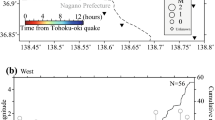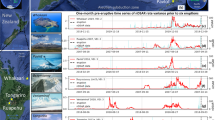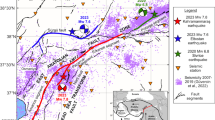Abstract
Forecasting of volcanic eruptions is still inadequate, despite technological advances in volcano monitoring. Improved forecasting requires a deeper understanding of when unrest will lead to an actual eruption. Shallow, long-period seismic events often precede volcanic eruptions and are used in forecasting. They are thought to be generated by resonance in fluid-filled cracks or conduits, indicating the presence of near-surface magmatic fluids. Here we analyse very-high-resolution seismic data from three active volcanoes—Mount Etna in Italy, Turrialba Volcano in Costa Rica and Ubinas Volcano in Peru—measured between 2004 and 2009. We find that seismic resonance is dependent on the wave propagation path and that the sources for the long-period seismic waves are composed of short pulses. We use a numerical model to show that slow-rupture failure in unconsolidated volcanic materials can reproduce all key aspects of these observations. Therefore, contrary to current interpretations, we suggest that short-duration long-period events are not direct indicators of fluid presence and migration, but rather are markers of deformation in the upper volcanic edifice. We suggest that long-period volcano seismicity forms part of the spectrum between slow-slip earthquakes and fast dynamic rupture, as has been observed in non-volcanic environments.
This is a preview of subscription content, access via your institution
Access options
Subscribe to this journal
Receive 12 print issues and online access
$259.00 per year
only $21.58 per issue
Buy this article
- Purchase on Springer Link
- Instant access to full article PDF
Prices may be subject to local taxes which are calculated during checkout




Similar content being viewed by others
References
McNutt, S. R. Volcanic seismology. Annu. Rev. Earth Planet. Sci. 32, 461–491 (2005).
Wassermann, J. in IASPEI New Manual of Seismological Observatory Practice (NMSOP) Vol. 1 (ed. Bormann, P.) (GeoForschungsZentrum Potsdam, 2002).
Chouet, B. & Julian, B. R. Dynamic of an expanding fluid-filled crack. J. Geophys. Res. 90, 11187–11198 (1985).
Chouet, B. A. in Volcanic Seismology (eds Gasparini, P., Scarpa, R. & Aki, K.) 133–156 (Springer, 1992).
Neuberg, J., Luckett, R., Baptie, V. & Olsen, K. Models of tremor and low-frequency earthquake swarms on Montserrat. J. Volcanol. Geotherm. Res. 101, 83–104 (2000).
Jousset, P., Neuberg, J. & Sturton, S. Modelling the time-dependent frequency content of low-frequency volcanic earthquakes. J. Volcanol. Geotherm. Res. 128, 201–223 (2003).
Chouet, B. A. Long-period volcano seismicity: Its source and use in eruption forecasting. Nature 380, 309–316 (1996).
Nakano, M., Kumagai, H. & Chouet, B. A. Source mechanism of long-period events at Kusatsu-Shirane Volcano, Japan, inferred from waveform inversion of the effective excitation functions. J. Volcanol. Geotherm. Res. 122, 149–164 (2003).
Matsubara, W. et al. Distribution and characteristics in waveforms and spectrum of seismic events associated with the 2000 eruption of Mt. Usu. Earth Planet. Sci. Lett. 136, 141–158 (2004).
Lokmer, I., Saccorotti, G., Di Lieto, B. & Bean, C. J. Temporal evolution of long-period seismicity at Etna Volcano, Italy, and its relationships with the 2004–2005 eruption. Earth Planet. Sci. Lett. 266, 141–158 (2008).
Bean, C. J., Lokmer, I. & O’Brien, G. S. Influence of near-surface volcanic structure on long-period seismic signals and on moment tensor inversions: Simulated examples from Mount Etna. J. Geophys. Res. 113, B08308 (2008).
Tromp, J., Tape, C. & Liu, Q. Seismic tomography, adjoint methods, time reversal and banana-doughnut kernels. Geophys. J. Int. 160, 195–216 (2005).
De Barros, L. et al. Source geometry from exceptionally high resolution long period event observations at Mt. Etna during the 2008 eruption. Geophys. J. Int. 36, L24305 (2009).
Harrington, R. M. & Brodsky, E. E. Volcanic hybrid earthquakes that are brittle-failure events. Geophys. Res. Lett. 34, L06308 (2007).
O’Brien, G. S. et al. Time reverse location of seismic long-period events recorded on Mt Etna. Geophys. J. Int. 184, 452–462 (2011).
De Barros, L. et al. Source Mechanism of Long Period events recorded by a high density seismic network during the 2008 eruption on Mt Etna. J. Geophys. Res. 116, B01304 (2011).
Benson, P. M., Vinciguerra, S., Meredith, P. G. & Young, R. P. Laboratory simulation of volcano seismicity. Science 322, 249–252 (2008).
Burlini, L. et al. Seismicity preceding volcanic eruptions: New experimental insights. Geology 35, 183–186 (2007).
Harrington, R. M. & Benson, P. M. Analysis of lab simulations of volcanic hybrid earthquakes using empirical Green’s functions. J. Geophys. Res. 116, B11303 (2011).
Kanamori, H. & Rivera, L. Static and dynamic scaling relations for earthquakes and their implications for rupture speed and stress drop. Bull. Seismol. Soc. Am. 94, 314–319 (2004).
Solaro, G. et al. Anatomy of an unstable volcano from InSAR: Multiple processes affecting flank instability at Mt. Etna. J. Geophys. Res. 115, B10405 (2010).
Neri, M. et al. The changing face of Mount Etna’s summit area documented with Lidar technology. Geophys. Res. Lett. 35, L09305 (2008).
Gil-Cruz, F. & Chouet, B. A. Long-period events, the most characteristic seismicity accompanying the emplacement and extrusion of a lava dome in Galeras Volcano, Colombia, in 1991. J. Volcanol. Geotherm. Res. 77, 121–158 (1997).
Arciniega-Ceballos, A., Valdes-Gonzalez, C. & Dawson, P. Temporal and spectral characteristics of seismicity observed at Popocatepetl volcano, central Mexico. J. Volcanol. Geotherm. Res. 102, 207–216 (2000).
Saccorotti, G. et al. Seismicity associated with the 2004–2006 renewed ground uplift at Campi Flegrei Caldera, Italy. Phys. Earth Planet. Int. 165, 14–24 (2007).
De Luca, G., Scarpa, R., Del Pezzo, E. & Simini, M. Shallow structure of Mt. Vesuvius Volcano, Italy, from seismic array analysis. Geophys. Res. Lett. 24, 481–484 (1997).
Chouet, B. A. et al. Shallow velocity structure of Stromboli volcano, Italy, derived from small-aperture array measurements of Strombolian tremor. Bull. Seismol. Soc. Am. 88, 653–666 (1998).
Ferrazzini, V., Aki, K. & Chouet, B. A. Characteristics of seismic waves composing hawaiian volcanic tremor and gas-piston events observed by a near-source array. J. Geophys. Res. 96, 6199–6209 (1991).
Mora, M. M. et al. Shallow velocity structure and seismic site effects at Arenal volcano, Costa Rica. J. Volcanol. Geotherm. Res. 152, 121–139 (2006).
Broberg, K. B. Differences between Mode I and Mode II crack propagation. Pure Appl. Geophys. 163, 1867–1879 (2006).
Abraham, F. F. & Gao, H. How fast can cracks propagate? Phys. Rev. Lett. 84, 3113–3116 (2000).
O’Brien, G. S. & Bean, C. J. A 3D discrete numerical elastic lattice method for seismic wave propagation in heterogeneous media with topography. Geophys. Res. Lett. 31, L14608 (2004).
Apuani, T., Corazzato, C., Cancelli, A. & Tibaldi, A. Physical and mechanical properties of rock masses at Stromboli: A dataset for volcano instability evaluation. Bull. Eng. Geol. Environ. 64, 419–431 (2005).
Sato, T. A note on body wave radiation for expanding tension crack. Sci. Rep. Tohoku Univ. Ser. 5, Geophys. 25, 1–10 (1978).
Peng, Z. & Gomberg, J. An integrated perspective of the continuum between earthquakes and slow-slip phenomena. Nature Geosci. 3, 599–607 (2010).
Rubin, A. Episodic slow slip events and rate-and-state friction. J. Geophys. Res. 113, B11414 (2008).
Madariaga, R. Dynamics of an expanding circular fault. Bull. Seismol. Soc. Am. 3, 639–666 (1976).
Amitrano, D. Brittle-ductile transition and associated seismicity: Experimental and numerical studies and relationships with the b value. J. Geophys. Res. 108, 2044–2059 (2003).
Collins, B. D. & Sitar, N. Geotechnical Properties of Cemented Sands in Steep Slopes. J. Geotech. Geoenviron. Eng. 135, 43–51 (2009).
Sakuma, S., Kajiwara, T., Nakada, S., Uto, K. & Shimizu, H. Drilling and logging results of USDP-4—Penetration into the volcanic conduit of Unzen Volcano, Japan. J. Volcanol. Geotherm. Res. 175, 1–12 (2009).
Brantut, N., Schubnel, A. & Guéguen, Y. Damage and rupture dynamics at the brittle-ductile transition: The case of gypsum. J. Geophys. Res. 116, B01404 (2011).
McNutt, S. R. in Encyclopedia of Volcanoes (eds Sigurdsson, H. et al.) 1095–1119 (Academic, 2000).
Sparks, R. S. J., Biggs, J. & Neuberg, J. W. Montoring volcanoes. Science 335, 1310–1311 (2012).
Acknowledgements
Financial support from Science Foundation Ireland (SFI) and the European Commission, and computational support from the Irish Centre for High End Computing (ICHEC), are acknowledged. We are grateful to M. Mora, J. Pacheco, F. Martini and G. Soto (Costa Rica), O. Macedo and A. Inza (IGP-Peru). M. Möllhoff, D. Patanè (D.P.) and INGV staff (Italy) for field campaign support and D.P. for feedback on an early manuscript. D. Amitrano is gratefully acknowledged for application of his damage mechanics code and A. Braiden for assistance with drafting the manuscript. T. Eyre is thanked for Supplementary Fig. 1.
Author information
Authors and Affiliations
Contributions
C.J.B. initiated the concepts, analysed synthetic seismicity data and wrote the manuscript. L.d.B. analysed the seismic data and, with I.L., helped develop the concepts. J-P.M. provided data and intellectual input. G.O’B. carried out rupture modelling and S.M. made contributions on source modelling.
Corresponding authors
Ethics declarations
Competing interests
The authors declare no competing financial interests.
Supplementary information
Supplementary Information
Supplementary Information (PDF 380 kb)
Rights and permissions
About this article
Cite this article
Bean, C., De Barros, L., Lokmer, I. et al. Long-period seismicity in the shallow volcanic edifice formed from slow-rupture earthquakes. Nature Geosci 7, 71–75 (2014). https://doi.org/10.1038/ngeo2027
Received:
Accepted:
Published:
Issue Date:
DOI: https://doi.org/10.1038/ngeo2027
This article is cited by
-
A Review of the Source Characteristics and Physical Mechanisms of Very Long Period (VLP) Seismic Signals at Active Volcanoes
Surveys in Geophysics (2024)
-
Distributed dynamic strain sensing of very long period and long period events on telecom fiber-optic cables at Vulcano, Italy
Scientific Reports (2023)
-
Imaging and seismic modelling inside volcanoes using machine learning
Scientific Reports (2023)
-
Activated volcanism of Mount Fuji by the 2011 Japanese large earthquakes
Scientific Reports (2023)
-
Fibre optic distributed acoustic sensing of volcanic events
Nature Communications (2022)



